Extract from the Council Meeting
Upper Queen Street Estate
A Right-of-way problem in connection with Rushden’s No. 3 post-war permanent housing site is to be studied in consequence of a discussion at the Urban Council’s meeting on Wednesday.
It was agreed that amended plans for the layout of the Upper Queen Street estate should be sent to the Ministry of Health for approval.
Coun. Cox said they incorporated a new road which might obviate the Council’s objections to a previous plan. The main difference was that the road would carry traffic right through to the new industrial zone “round the back.”
Coun. Sawford wanted to know if anything had been done regarding a right of way into Rectory Road.
The Surveyor (Mr. J. E. Johnson) said provision was made on the plans.
The Clerk (Mr. A. G. Crowdy) said the only way of obtaining a public road would be to acquire the necessary land. This would be expensive.
Mr. Cox thought it wise to take some steps to carry out Mr. Sawford’s suggestion. The committee would consider it.
Urgent Need
Anxious to arrange further contracts for the erection of houses, the Housing Committee has arranged to approach the Regional Housing Officer.
“The committee considers there is urgent need for further contracts,” said Coun. T. W. Cox, who added, in reference to building now in progress, that they were “doing very well,” but hoped to do a little better in January and February.
Extract from Council Meeting June 1949
48 Houses - It was agreed to ask for permission to invite tenders for the erection of 48 houses in groups of twelve on the Upper Queen Street Estate. The Housing Committee also reported that they would inspect the new “Unity” houses at Chingford, Essex, with a view to erecting twenty of them.
|
The Rushden Echo and Argus, 16th December 1949, transcribed by Gill Hollis
Forty-Six Homes to Be Built - Council Will Use 1949 Allocation
Hurrying to take final advantage of the 1949 allocation, no part of which can be carried over to next year, Rushden Urban Council made arrangements on Wednesday for 46 homes to be built.
Following consultation with Ministry of Health officials, it was agreed to place contracts for 24 houses in Upper Queen Street, at a cost of over £32,000 (including £360 for cookers, on which the Ministry insists) and for 16 houses in the same area at a cost of over £22,000.
Six houses will be built in Boundary Avenue at a cost of £8,100, and all three batches will come under the 1949 allocation.
According to the Ministry of Health an amended tender received by the Council for the construction of Unity houses at £40,833 is £3,500 in excess of the figure that the Ministry would be prepared to approve. The Ministry have suggested certain measures of economy, and the Council will attempt to obtain a lower tender. These houses will then be part of the 1950 allocation of 60 houses, not more than one-tenth of which may be built by private enterprise.
Another Housing Committee plan is to acquire further land and extend the Upper Queen Street site to provide for a further 98 houses.
|
The Rushden Echo and Argus, 6th June, 1952, transcribed by Jim Hollis
Rapid Growth of First Flats - But new estate has variety
Hold hard a moment you people who say Rushden never changes! Before you say another word take a walk through Queen Street and into Rushden’s mushrooming housing estate, where nearly 100 builders are fast making a new suburb for the town.
More than 100 homes are at present springing up. The scenery is literally changing every minute. All this is taking place in an area 400 yards square, bounded by Denton’s Close, Balmoral Avenue, Gloucester Avenue and Lancaster Way.
Six months ago it was pasture – a popular Sunday evening “country walk” for local people. Now it is be-ribboned with new concrete roads and echoes to the sound of trowels and mallets.
In this new area the council’s first flats – as distinct from maisonettes – are being built, and they will eventually house 32 families. These flats – the Gregory type – are already nearing completion and should be ready in July.
No monotony
Within hailing distance of the flats are five different types of homes. Their different design and varying coloured facades will break the monotony that became an accepted fact with pre-war council house estates.
When an “Echo and Argus” reporter visited the estate he chatted with a Balmoral Avenue housewife. She said she had been living there only a few months and that every day brought new neighbours.
Her biggest bugbear, as with all the other nearby women, is the distance of her home from the shopping centre. She is nearly half a mile from High Street and finds the walk back up Queen Street’s slope very tiring when she is pushing a pram and carrying her newly-bought provisions.
Mobile Shops
But things are gradually changing, she explained. Almost daily the estate is being visited by “mobile shops.” The vans, with their green-grocery, fish, and even ice cream, are a great boon to the estate’s housewives.
In the centre of the building area is Fosse Green, on which space has been reserved for two or three shops. Whether the council will build the shops and let them, or alternatively sell the space, is still a matter for conjecture.
Yes, Rushden is changing and growing fast. Even while the reporter chatted, another half-dozen concrete paving slabs had been laid and the path was three yards nearer Higham Ferrers.
|
The Rushden Echo and Argus, 26th June, 1953, transcribed by Gill Hollis
Rushden’s ‘Royal’ Estate Pushes On - New ideas for eastern wing of town
It is such a climb to Rushden’s easternmost point of advance that many people in the town have never seen the “Royal” estate which stretches out towards the sunrise. When they do make the effort they will find the journey rewarding.
Attracted by the announcement that the Urban Council hopes to put its 500th post-war house into service next week, “Echo and Argus” reporters visited the Upper Queen Street estate on Wednesday afternoon. They turned left from the long familiar stub of Upper Queen Street, turned right from the end of a typical modern street, and went ahead as far as the road would carry them.
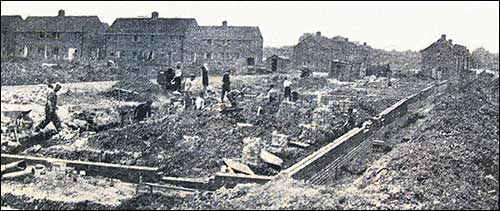 |
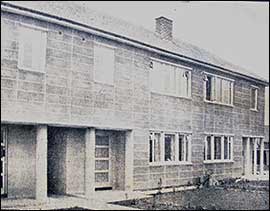 |
|
Some of the highest land on the fringe of Rushden has provided a fine site for
several new streets, all with blue-blooded names.
|
Gloucester Crescent where houses have been occupied more than 12 months
|
They passed houses complete and occupied, houses soon to be ready, houses just showing above ground, and trenches ready to receive still more houses. The road tailed off from fairish to rough, from rough to rugged, and from rugged to dirt track status.
Even then, well beyond the last trenches and the bright shirts of young labourers, the double-deck kerbs of concrete on either side of the hollowed-out track thrust confidently eastward until they came to a hedge and a vista of pea fields in full flower.
North View
That was where the reporters decided to get their bearings. Looking right, they identified a house of mature age that used to stand alone remote in the “country.”
Looking left, they saw the church tower and spire of Higham Ferrers, a chimney on the Chelveston side of Higham, a cloud of steam from the borough railway sidings, and, to the left of all this, the roof of the Methodist Church in Higham High Street.
It needed another turn to fix the Tollbar estate (where Rushden joins with Higham) across no more than a couple of fields and a few more degrees to discover the country end of Rushden’s Prospect Avenue. For the gas works – second only to the churches as a landmark – the line was almost due west. The observers were, in fact, looking back – and quite a long way.
Over the various hedges it seemed quite a district for peas, but in front of them urbanism – streets, excavations, bricks, lorries, machines and men – was established beyond recall.
Even with its rough edges, you couldn’t help liking the estate. You saw “Windsor Road” and “Balmoral Avenue” on the low brick walls of front gardens. You found Kent Road – though the plates were not yet fixed – and got uncertain evidence from a workman about the existence of Lancaster Street.
Still better than the blue-blooded names were the variety of design and colour, the generous width of footways, the show of prosperity and good intent wherever houses were occupied.
Curtains “up” and “down” matched in nearly every case. Front windows – some in long bay form – gave glimpses of good furnishing. Modern heating requires few chimneys, but TV requires one stack per house, and the architect who designs a chimneyless dwelling had better look out. One could not shake off the impression that the aerials go up before the tenants go it.
Paint, porches, verandahs, and lamp-posts assert new ideas. Doors may be green, blue or pink. Canopies may rest on pillars fat or thin. The lamp-posts hug the garden walls, not the outer edge of the pavement.
Where flats exist, those on the upper floor have their own entrances at the sides of the block.
There are no long, uniform rows on this estate, but the general lay-out is by no means fussy, and the pre-war craze for tying streets into knots replete with dead ends and gannick ways appears to have spent itself.
Gloucester Crescent is perhaps the principal challenge to conventional design, for the houses are made of precast blocks, coated with a chocolate colour and lined-off in yellow where the blocks join. Canopies and other features heighten the novelty, but do not hide the fact that the elusive gift of perpetual freshness is needed to sustain the original effect.
Another idea in the crescent is to vary the positions of rooms in order to admit the sun where it is most welcome. These houses also have excellent gardens both back and front, and already some of the front plots have been laid out most meticulously by the tenants.
It was a neat little house-wife of Gloucester Crescent who said on Wednesday: “We appreciate it here because we came in from the country, where we had never had conveniences and sanitation.”
|
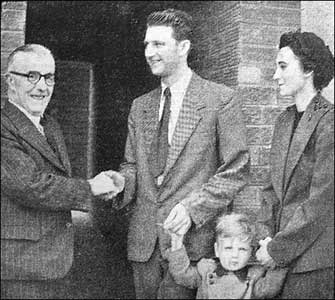 |
| Congratulations beamed Mr C Ginns, chairman of Rushden Urban Council’s housing committee, as he handed over the keys to 72 Gloucester Crescent to Mr and Mrs Colin Page at a ceremony marking the completion of the town’s 500th post-war house—on the Upper Queen Street estate—last Saturday. |
The Rushden Echo and Argus, 10th July 1953, transcribed by Jim Hollis
Rushden’s 500th House Handed Over
Mrs. O. A. H. Muxlow and Mr. Joseph Allen who saw the first of Rushden post-war houses – a pre-fab on the Southfields estate – opened in 1946 were among Saturday’s company of councillors at a ceremony at the 500th post-war council house.
The key of the house 72 Gloucester Crescent, Upper Queen Street estate, was handed over by the chairman of the housing committee (Mr. C. Ginns) to the tenants, Mr. and Mrs. Colin Page, formerly of 28 Shirley Road.
Mr. Ginns said that in sharing their pleasure in the occasion they could also be proud of the number of homes they had built since the war.
The council now owned 1,297 houses and their post-war expenditure on housing – with the 1953-4 programme in hand for the Upper Queen Street estate – would be £906,400. The next step, he said, would be the clearance of unfit houses.
After Mr. Page had unlocked the front door, he and his wife with their young son, Ian, conducted their official guests round the house.
|
The Rushden Echo and Argus, 18th June, 1954, transcribed by Jim Hollis
Council Fix More Props - But moving house is till a puzzle
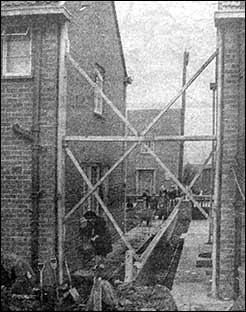 |
|
No 5 Kent Road
Wooden Bracing has been erected – the house has moved so much that gaps are showing between walls and door frames.
|
Just over 12 months ago Mr. and Mrs. William Harris and their family moved into a brand new Council house at 5 Kent Road, Rushden. The future looked rosy.
Today that council house looks far from new. Inside, upstairs especially, the walls are covered with cracks; in the bathroom great chunks of plaster keep falling away from the wall.
Outside there are mounds of earth and clay, which workmen have removed from beneath the foundations in an effort to stop the movement which is causing all the trouble.
Subsiding
Mrs. Harris has been given no clear reason why all this is happening. One theory is that water had run under the house and could not drain off; another is that the house is subsiding on to clay base running a few feet below ground level.
First measure to stop the movement was the erection of wooden bracing just before Whitsun. A dual arrangement of shoring was fixed this week.
Keeping her fingers crossed that the house does not make a further move, Mrs. Harris is somewhat relieved after being told that the Urban Council will redecorate her house.
|
|
Rushden Echo & Argus, 22nd October 1954
On the Upper Queen Street estate 341 houses have been completed and 68 are under construction. Twenty have been occupied during the last month, and two should be ready during the next month.
|
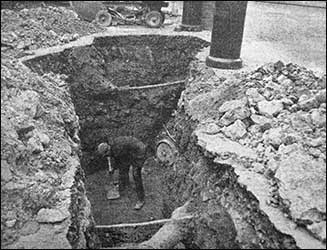 |
| Rushden Echo & Argus, 29th Oct 1955
No, he doesn’t want to get through to Australia.
He is just one of the workmen engaged on work in Portland Road, Rushden, where this giant “hole in the road” is part of work in connection with drainage for Rushden’s housing estate at the top of the town.
|
|
The Rushden Echo and Argus, 21st September 1959
|
|
Popularly known as Rushden's "Royal' estate, the Upper Queen Street area is the newest development of council housing in the town and already the largest post-war sector.
From Balmoral Avenue in the foreground the picture looks across to the Town Sports Ground, where the football grandstand is easy to pick out, and the estates on either side of Newton Road, which threads towards the top left-hand corner of the view.
The Baptist Sports Ground, with portions enclosed for tennis and bowls, is seen to the left of the new streets, from which an embryo road already connects, along by the town Ground, with pre-war Hove Road.
The lane towards Chelveston crosses the picture just above the middle, and there is a glimpse of the road to Bedford (top right).
|
|
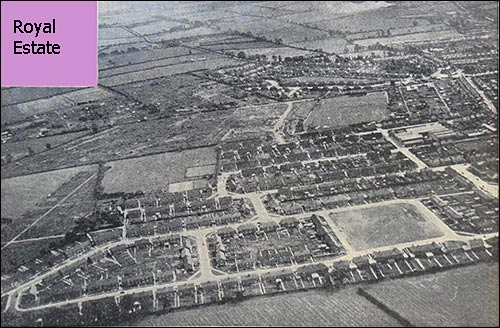 |
|
Aerial view of the 'Royal Estate'
|
|





